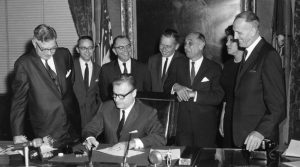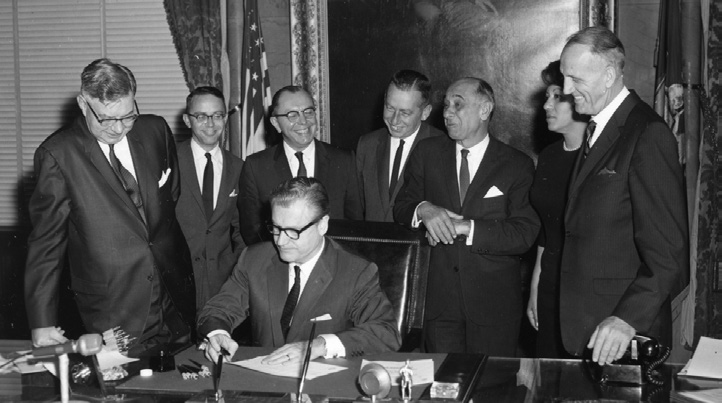
Gov. Nelson A. Rockefeller, seated, signs the Public Employees Fair Employment Act, known as the Taylor Law, in 1967. From left to right, then CSEA President Joseph Feily; Rockefeller aide and former CSEA counsel Harry Albright; state Budget Director T. Norman Hurd; Lt. Gov. Malcolm Wilson; Attorney General Louis Lefkowitz; Ersa Poston, chair of the state Civil Service Commission, unidentified woman and incoming CSEA President Theodore Wenzl. Photo courtesy of New York State Archives.
Over the past 58 years, the state Public Employees Fair Employment Act — better known as the Taylor Law — has given our union the right, under the law to negotiate fair wages, strong health benefits and workplace protections for union members.
Many elected leaders throughout New York had long acknowledged CSEA as a legitimate public employee representative. However, before the Taylor Law was enacted, our union legally didn’t have the right to bargain collectively with employers.
Improving restrictive policies
Before the Taylor Law, public employee labor rights were covered under the state’s Condon-Wadlin Act (1947), which prohibited public employees from striking, did not allow collective bargaining and didn’t give workers an alternative means for settling labor-management disputes. This restrictive law led to labor unrest in some areas in New York during the 1960s, including a New York City transit strike that cost the state and city’s economy more than $1 billion.
To address the unrest, Gov. Nelson Rockefeller formed a commission to examine public-sector labor relations and draft reforms to Condon-Wadlin. George Taylor, a University of Pennsylvania professor, chaired the commission, commonly known as the Taylor Commission.
The commission made several recommendations that were considered controversial at the time, including formal recognition of public employee representatives and a mechanism for collective bargaining as a way to resolve labor-management conflicts.
In addition to giving public employees the legal right to collectively bargain, the legislation also established a charter of rights for public employees and established the state Public Employment Relations Board (PERB) to oversee the law.
Among those who drafted the new law was Jerome Lefkowitz, a state Department of Labor attorney who would later serve as CSEA’s Deputy Counsel for 20 years.
Rockefeller signed the state Public Employees Fair Employment Act — or the Taylor Law — into law on April 21, 1967 and went into effect in September 1967.
Serious strike ramifications
While the Taylor Law improved many of the provisions of Condon- Wadlin, the Taylor Law also prohibits strikes by public employees. Those who participate in illegal strikes may face serious penalties, including fines, suspension or dismissal.
The Taylor Law, and the 1982 Triborough Amendment, which bars public employers from changing provisions of expired labor agreements until a new contract is reached, have guided our work in securing fair agreements. Without this amendment, many of our workplace protections could be jeopardized, along with the quality of public services that our members and other public workers provide in New York every day.
Under Triborough, unions also risk losing certain protections and bargaining advantages if they engage in a strike. Additionally, PERB can impose penalties, including withholding union dues collection privileges. Employers may also seek court injunctions, and noncompliance can lead to further legal action, including but not limited to civil and criminal contempt. Financially, employees may be docked two days’ pay for each strike day under the “two-for-one” penalty and they may lose their health insurance.
Strikes can also erode public trust and damage labor relations, weakening future negotiations. While our union may use other forms of advocacy, striking can have lasting legal and financial repercussions for CSEA members and our union.
In April 2018, the Taylor Law was amended. The changes include giving public employee unions the option not to provide representation to nonmembers for any services beyond those included in collective bargaining agreements, including disciplinary cases.
The amended law also requires public employers to notify employee representatives with a list of new employees and their contact information, as well as a chance to meet with the new employees, within 30 days of employment. Another change to the law allows members who return from a leave in employment to return as members.
Despite its restrictions on strikes, the Taylor Law has been instrumental in shaping fair labor practices for public employees across New York. It has provided a framework for stability in labor relations, ensuring that workers have a voice in negotiating their wages, benefits, and working conditions.


